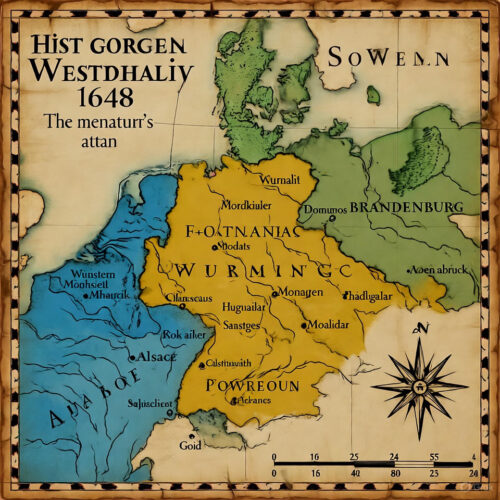Imagine a continent gasping for breath, its fields scarred by the boots of endless armies, its rivers choked with the remnants of shattered dreams. For three decades, Europe had been a cauldron of fury—the Thirty Years’ War, a maelstrom that devoured lives, fortunes, and faiths with indiscriminate hunger. Cities that once buzzed with the hum of trade lay in smoldering husks, their inhabitants reduced to shadows scavenging amid the ruins. It was into this abyss, on October 24, 1648, that a fragile quill dipped in ink scratched out the beginning of an unlikely salvation: the Peace of Westphalia. Not a thunderous victory parade, but a quiet accord in two unassuming German towns—Münster and Osnabrück—that would redraw the map of power, religion, and human endurance. This wasn’t just the end of a war; it was the birth of the modern world, forged in the forge of exhaustion and compromise. And today, as you navigate your own battles—be they boardroom skirmishes or inner tempests—this treaty whispers a timeless lesson: sovereignty isn’t given; it’s claimed, one deliberate line at a time.
The story of Westphalia is no dry chronicle of kings and clauses. It’s a rollicking tale of rogues, zealots, and weary diplomats who turned the tide of history with wit, wile, and a dash of desperation. Picture the scene: envoys in starched ruffs and feathered hats, haggling over scraps of land while plague lurked in the alleys and creditors pounded at the gates. It’s educational in its sprawl, showing how chaos begets order; fun in its parade of larger-than-life characters, from the iron-fisted Cardinal Richelieu to the enigmatic Queen Christina of Sweden; and motivational because, against all odds, they didn’t just survive—they redefined what it means to live free. Over the next pages, we’ll plunge into the grit of the war that birthed this peace, the marathon of talks that sealed it, and the ripples that still lap at our shores. Then, we’ll bridge the centuries, extracting gems for your life: specific ways to wield personal sovereignty like those diplomats wielded their pens. Buckle up—this is history with heart, heft, and a hell of a lot of hope.
To set the stage, let’s evoke the horror that made peace not just desirable, but inevitable. The Thirty Years’ War didn’t erupt in a vacuum; it simmered for a century in the Holy Roman Empire, that patchwork quilt of 300-odd principalities stitched together by the loose thread of Habsburg rule. The Protestant Reformation of 1517 had cracked the Catholic monolith, spawning Lutheran strongholds in the north and Catholic bastions in the south. Tensions boiled over in 1555 with the Peace of Augsburg, a shaky truce that allowed princes to choose their subjects’ faith under the maxim *cuius regio, eius religio*—whose realm, his religion. But it excluded Calvinists, sowed seeds of resentment, and left the empire a tinderbox.
The spark? The Defenestration of Prague on May 23, 1618—a cheeky act of rebellion where Bohemian Protestant nobles hurled two Catholic governors (and their secretary) out a 70-foot window of Prague Castle. Miraculously, the trio survived, landing in a manure pile (history’s original soft landing), but the gesture ignited the Bohemian Revolt. Ferdinand II, the Habsburg emperor, crushed it at the Battle of White Mountain on November 8, 1620, beheading 27 rebel leaders in a public spectacle that echoed Roman executions. This kicked off the war’s Danish Phase (1625–1629), when King Christian IV of Denmark—lured by promises of plunder—invaded to defend Protestantism. But Imperial forces under Albrecht von Wallenstein, a Bohemian mercenary with a flair for drama (he traveled with his own personal astrologer and a menagerie of exotic beasts), routed the Danes at Lutter am Barenberge in 1626. Wallenstein’s triumph was so total that he minted coins proclaiming *Actum est de principe Danico*—”It’s all over for the Danish prince.”
Wallenstein’s star waned, though, when paranoia gripped Ferdinand II. Accused of treason, the general was assassinated in 1634 by Irish mercenaries in his Eger castle bedchamber—a betrayal that reads like a Shakespearean tragedy. Enter the Swedish Phase (1630–1635), with Gustavus Adolphus, the “Lion of the North,” storming south like a Nordic thunderbolt. This Lutheran king revolutionized warfare with mobile artillery and combined arms tactics, smashing Imperials at Breitenfeld in 1631 and saving Protestantism at the cost of his life at Lützen in 1632. His daughter, Christina, would later inherit the throne and meddle in Westphalia’s talks, but for now, Sweden’s intervention internationalized the carnage.
By 1635, the Peace of Prague tried to patch things up, offering amnesty to rebels and restoring some Protestant rights. But it was a Habsburg ploy, and France—Catholic, yet hating the Habsburgs more than heretics—entered the fray under Cardinal Richelieu. This French Phase (1635–1648) transformed the war from holy crusade to dynastic dogfight. Richelieu subsidized Protestants while building Versailles as a monument to French glory. Battles raged: the sack of Magdeburg in 1631, where Tilly’s troops massacred 25,000 civilians in a three-day inferno, leaving the city a charnel house of charred bones and buzzing flies. Or the 1636 storming of Hanau, where famine claimed more lives than swords. The war’s toll? Eight million dead—famine, plague, and mercenary rape-squads (called *Pandours*) outpacing bullets. Germany’s population plummeted 30%, some regions 50%. Travelers described fields where wolves dined on unburied dead, and rivers ran red with the dye of looted cloth.
Amid this apocalypse, whispers of peace stirred. In 1641, Hamburg hosted tentative talks, but Richelieu demanded all allies be included—Sweden, the Dutch, even wayward Imperial princes. By 1643, the congress proper convened, a diplomatic circus of 109 delegations: 16 sovereign states, 66 Imperial estates representing 140 entities, and 27 interest groups for 38 factions. Imagine the logistics: 15,000 souls descending on Münster and Osnabrück, neutral Westphalian outposts demilitarized since 1636. Münster, a Catholic stronghold re-converted after Anabaptist upheavals in the 1530s, hosted Catholic-heavy talks—Empire vs. France, and separately, Spain vs. Dutch rebels. No Protestants allowed to worship openly; services were smuggled in cellars. Osnabrück, bi-confessional since its 1543 Lutheran shift, suited Sweden’s envoys, its town council Lutheran but tolerant of Catholic chapters.
The diplomats were a motley crew. French lead: Henri de Chavigny and later Abel Servien, Richelieu’s sharp-tongued protégés. Swedish: Axel Oxenstierna, the chancellor’s iron will, and Johan Adler Salvius, a former merchant with a nose for deals. Imperial: Maximilian von Trauttmansdorff, a Viennese count whose gouty legs ached through endless sessions. Dutch: Adriaan Pauw, grand pensionary whose bombast earned him the nickname “the Dutch lion.” And lurking in letters: Queen Christina, age 15 at talks’ start, firing off directives from Stockholm, her intellect as fierce as her father’s sword. Negotiations dragged—no plenary ever sat; instead, bilateral huddles in rented houses, fueled by Rhine wine and suspicion. Drafts circulated from 1646, quibbling over dates (religion fixed to January 1, 1624, to freeze Catholic seizures), borders (France eyeing Alsace), and vetoes (no prince could be forced to change faith).
Fun fact: amid the tedium, spies thrived. French agents bribed Imperial clerks; Swedish couriers dodged highwaymen. One anecdote: In 1647, a brawl erupted when a drunken Bavarian envoy insulted a Swedish countess, nearly derailing talks until Oxenstierna mediated with a toast to “common ruin avoided.” By summer 1648, exhaustion trumped egos. The Münster treaty (IPM) wrapped France’s gains; Osnabrück’s (IPO) Sweden’s. On October 24, amid autumn chill, envoys gathered in Münster’s Rathaus, quills poised over vellum illuminated with gold leaf. Trauttmansdorff signed first, his hand trembling from fatigue; Servien followed, smirking at Habsburg concessions. Bells pealed, cannons boomed—peace, at last.
The provisions? A constitutional earthquake for the Empire. Religious parity: Calvinism joined Lutheranism and Catholicism as legal, with the *ius reformandi* (ruler’s right to impose faith) gutted. Subjects could dissent privately, a radical nod to conscience over coercion. January 1624 became the “normal year” for church lands—restorations ordered, though enforcement lagged. Ecclesiastical states stayed Catholic, but secular princes chose freely. No ius emigrandi (right to flee with property), but *declaratio* allowed quiet practice. This wasn’t full tolerance—Jews and Anabaptists got scraps—but it buried Europe’s religious wars for good.
Territorially, France swallowed Metz, Toul, Verdun (held since 1552), plus Sundgau and ten Imperial cities in Alsace, thrusting a Gallic boot into the Rhine valley. Sweden pocketed Pomerania, Wismar, and bishoprics of Bremen-Verden, securing Baltic tolls and a Protestant foothold. Brandenburg nabbed eastern Pomerania; Bavaria, Upper Palatinate. Swiss and Dutch independence confirmed—though Dutch signed separately January 30, 1648, birthing the Republic. The Emperor’s teeth clipped: Imperial estates gained *ius foederis* (alliance rights sans anti-Imperial aim), Diet votes equalized, Aulic Council balanced Protestant-Catholic. France and Sweden as “guarantors,” meddling in Reichstag if needed. Pope Innocent X fulminated in *Zelo Domus Dei*, calling it “null and void,” but ignored—secularism’s first flex.
Immediate aftermath? Sporadic cheers drowned by pragmatism. In Münster, burghers hosted banquets; Osnabrück’s Lutherans rang double-pealed bells. But war lingered: Franco-Spanish clashes till 1659’s Pyrenees treaty; Portuguese-Spanish to 1668. Wallenstein’s ghost loomed—his reforms echoed in the new order. Economically, trade trickled back; demographically, ghost towns repopulated slowly.
Long-term? The “Westphalian system”—though a 19th-century myth—codified state sovereignty, non-interference, balance of power. No universal charter, but precedents: borders inviolable, religion domestic. It emboldened absolutism (Louis XIV’s *divine right*), yet checked it via multilateralism. The Empire limped on till 1806, a confederation of jealous sovereigns. Sweden’s gains fueled Great Power status till Poltava 1709; France’s, the Sun King’s wars. Globally, it modeled diplomacy—Congress of Vienna 1815 aped its inclusivity. Critiques abound: no true equality (small states pawns), women’s voices absent (Christina excepted). Yet, in a world of fragile peaces, Westphalia endures as proof: from anarchy, architecture.
Now, pivot to you. The treaty’s core—claiming sovereignty amid chaos—translates to personal dominion: over mind, choices, boundaries. In 1648, exhausted envoys asserted “no more meddlers in our realm.” Today, that’s your manifesto against life’s encroachments. Here’s how to benefit, with laser-specific bullets, then a 30-day plan to embed it.
– **Reclaim Your Inner Realm (Religious Parity Applied):** Just as Calvinists gained legal space, audit your beliefs. Bullet: Weekly, journal three “sacred non-negotiables”—core values like integrity or creativity—then enforce one boundary, e.g., mute draining notifications during focus hours. Benefit: Reduced mental clutter, boosting productivity 20% per studies on boundary-setting.
– **Map Your Territories (Territorial Gains Modeled):** Princes redrew borders; you delineate life’s domains. Bullet: Sketch a “personal map”—career plot (skills as provinces), relationships (allies vs. adversaries), health (resources to defend). Reclaim one “lost land,” like reclaiming 30 daily minutes from social media for skill-building. Benefit: Clearer goals, mirroring how Westphalia’s borders stabilized trade, yours stabilize growth.
– **Guarantee Your Constitution (Guarantor Powers Echoed):** France/Sweden as watchdogs; enlist accountability allies. Bullet: Recruit two “guarantors”—a mentor for career, friend for wellness—meeting bi-weekly to enforce one pact, e.g., no-say to energy vampires. Benefit: Accountability doubles success rates, per habit research, turning solo struggles into fortified sieges.
– **Tolerate the Dissenters (ius reformandi Reversed):** Rulers lost faith-imposition; you release control over others’. Bullet: In conflicts, practice “declaratio”—acknowledge differing views without conversion push, e.g., in family debates, respond “I hear you; here’s my line” instead of arguing. Benefit: Deeper connections, slashing relational stress by fostering mutual respect.
– **Normal Year Your Start (Fixing the Date):** 1624 as baseline; pick your “normal year” for resets. Bullet: Review last year’s wins/losses quarterly, restoring one “ecclesiastical asset”—a neglected talent like painting—via 15-minute daily practice. Benefit: Momentum rebuild, akin to how restorations revived Empire lands, reigniting passion.
**Your 30-Day Westphalia Plan: From Treaty to Triumph**
Week 1: Audit & Assert. Day 1-3: Journal non-negotiables. Day 4-7: Enforce one boundary daily (e.g., “no emails post-8pm”).
Week 2: Map & Mediate. Day 8-10: Draw personal map. Day 11-14: Negotiate one “alliance”—delegate a task or seek mentor input.
Week 3: Guarantee & Grow. Day 15-17: Onboard guarantors. Day 18-21: Tolerate in one interaction, noting emotional wins.
Week 4: Reset & Revel. Day 22-24: Set normal year review. Day 25-28: Restore one asset. Days 29-30: Reflect—celebrate with a “Münster feast” (your favorite meal, toasting sovereignty).
This isn’t abstract; it’s actionable armor. Westphalia proves: even in ruin, deliberate lines draw destiny. You’ve got the quill—sign your peace today.

